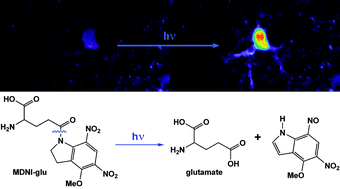Synthesis of a caged glutamate for efficient one- and two-photon photorelease on living cells
Abstract
We have synthesized a biologically inert, photosensitive derivative of the major excitatory

* Corresponding authors
a
Department of Pharmacology and Physiology, Drexel University College of Medicine, Philadelphia, USA
E-mail:
ged@drexel.edu
Fax: +1 215 762 2299
Tel: +1 215 762 8794
b Department of Neuroscience, University of Pennsylvania Medical Center, Philadelphia, USA
We have synthesized a biologically inert, photosensitive derivative of the major excitatory

 Please wait while we load your content...
Something went wrong. Try again?
Please wait while we load your content...
Something went wrong. Try again?
O. D. Fedoryak, J. Sul, P. G. Haydon and G. C. R. Ellis-Davies, Chem. Commun., 2005, 3664 DOI: 10.1039/B504922A
To request permission to reproduce material from this article, please go to the Copyright Clearance Center request page.
If you are an author contributing to an RSC publication, you do not need to request permission provided correct acknowledgement is given.
If you are the author of this article, you do not need to request permission to reproduce figures and diagrams provided correct acknowledgement is given. If you want to reproduce the whole article in a third-party publication (excluding your thesis/dissertation for which permission is not required) please go to the Copyright Clearance Center request page.
Read more about how to correctly acknowledge RSC content.
 Fetching data from CrossRef.
Fetching data from CrossRef.
This may take some time to load.
Loading related content
